Top 10 Data Integration Solutions for Companies with Larger Datasets in 2026
Summarize this article with:
✨ AI Generated Summary
Enterprise-scale data integration platforms are critical for unifying fragmented datasets, enabling real-time processing, maintaining data quality, and ensuring security and compliance. Key features to evaluate include scalability, real-time integration, automation, broad connector libraries, and ease of use. Leading solutions like Airbyte, Informatica, Talend, and MuleSoft offer diverse strengths in open-source flexibility, governance, AI-powered automation, and API-led connectivity to meet varied organizational needs.
Companies managing enterprise-scale datasets face a growing challenge: fragmented information scattered across multiple systems makes it difficult to turn data into actionable insights. Choosing the right data integration platform has become a strategic decision that directly shapes organizational agility and analytical success.
Modern enterprises need solutions that can handle massive volumes, support real-time processing, and maintain strict governance. The right platform transforms data silos into unified intelligence that drives smarter decisions across every business function.
This analysis reviews the most effective data integration solutions for 2026, focusing on real-time synchronization, advanced transformation, and custom integrations that meet unique business needs while ensuring security and compliance.
What Is Data Integration and Why Is It Important for Large Datasets?
Data integration represents the systematic process of combining information from disparate sources into unified, accessible formats that enable comprehensive analysis and business intelligence. This process transforms fragmented data landscapes into cohesive information ecosystems that support strategic decision-making across organizational functions.
For organizations managing large datasets, effective data integration becomes mission-critical due to several fundamental challenges. Data volume presents the most obvious obstacle, as information grows exponentially across multiple sources, formats, and storage systems. Without robust integration capabilities, organizations struggle to maintain data consistency and accessibility as their information assets expand.
Data complexity compounds volume challenges through the proliferation of diverse data formats, schemas, and source systems that require specialized handling and transformation logic. Modern enterprises typically manage structured data from relational databases alongside semi-structured information from APIs and unstructured content from documents and media files, all requiring different integration approaches and processing methodologies.
Data quality management becomes increasingly sophisticated with larger datasets, as integration processes must identify and resolve inconsistencies, duplicates, and errors across multiple source systems. Advanced integration platforms provide automated data profiling, validation, and cleansing capabilities that maintain information reliability while processing massive volumes of diverse data types.
The strategic importance of data integration for large datasets extends beyond technical requirements to encompass business enablement capabilities. Organizations with effective integration platforms can respond more rapidly to market changes, identify operational inefficiencies, and develop predictive insights that drive competitive advantage through comprehensive data visibility and analysis.
How Do Data Integration Solutions Compare Across Key Features?
Understanding the comparative capabilities of modern data integration platforms enables organizations to make informed decisions based on specific requirements, budget constraints, and technical capabilities. The following analysis examines critical features across leading solutions to highlight key differentiators and compatibility considerations.
The following comprehensive analysis examines ten leading data integration platforms specifically evaluated for their capability to handle enterprise-scale datasets while maintaining performance, reliability, and cost efficiency. Each solution addresses different organizational priorities, from open-source flexibility to enterprise governance requirements.
1. Airbyte: Open-Source and Cloud Solutions for Seamless Data Integration

Airbyte distinguishes itself as a leading open-source data integration platform specifically designed for modern cloud-native architectures and enterprise-scale deployments. The platform operates at large scale across customer environments while maintaining the flexibility and transparency that organizations require for custom data integration solutions.
Key features
- Open-source foundation with enterprise extensions providing complete transparency and customization capabilities
- Real-time Change Data Capture with continuous synchronization across 600+ pre-built connectors
- AI-powered connector development through natural language processing that reduces custom integration development time
- Multi-deployment flexibility supporting cloud, hybrid, and on-premises environments with consistent functionality
- Vector database integration enabling sophisticated AI and machine learning applications
- Enterprise-grade security including SOC 2, GDPR, and HIPAA compliance with comprehensive audit trails
2. Domo
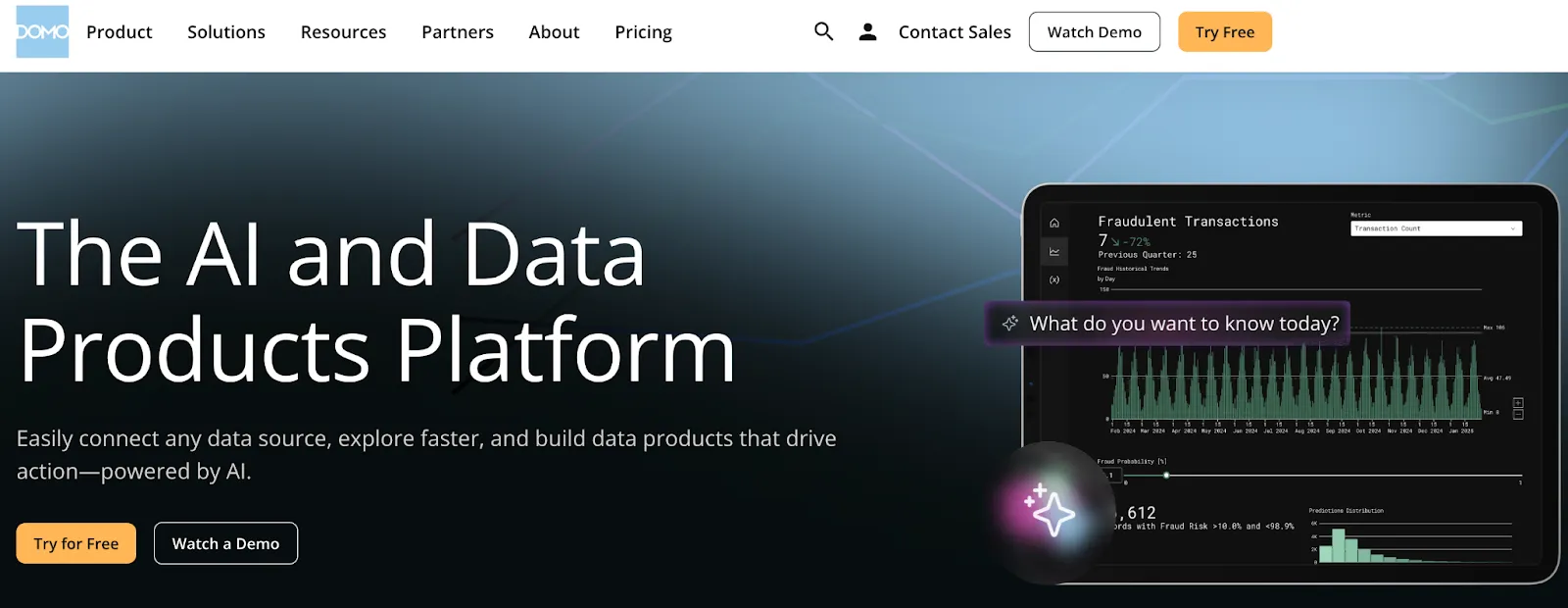
Domo represents a comprehensive business intelligence platform that combines data integration capabilities with advanced analytics and visualization tools. The platform provides end-to-end data management functionality that extends from initial data connection through final business intelligence delivery.
Key features
- Comprehensive connector library with over 1,000 native integrations supporting diverse data sources
- Real-time analytics capabilities that enable immediate insights from streaming data sources
- Advanced visualization tools with collaborative features for distributed teams
- Federated data connectors allowing access to data without requiring movement or replication
- Mobile-first design ensuring accessibility across devices and locations
3. Talend

Talend provides enterprise-grade data integration and governance capabilities through its comprehensive suite of data management tools. The platform emphasizes data quality and governance while maintaining support for both real-time and batch processing requirements across diverse organizational contexts.
Key features
- Cloud-native architecture optimized for modern data warehouse platforms
- Advanced data governance capabilities with comprehensive lineage tracking and quality management
- Integration with major cloud data warehouses including Snowflake, BigQuery, and Databricks
- Comprehensive data quality tools with automated profiling and cleansing capabilities
- Support for both code-based and visual development approaches
4. Informatica
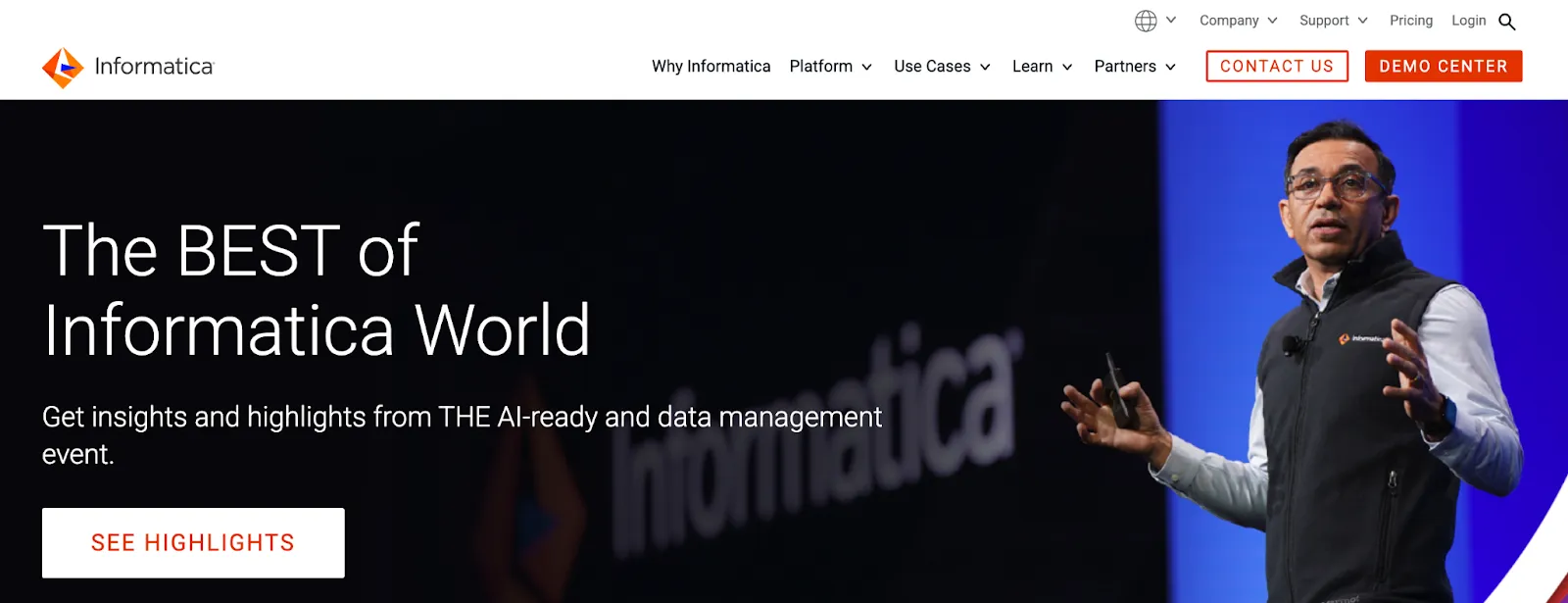
Informatica represents the traditional enterprise standard for data integration, offering comprehensive capabilities designed for large-scale, mission-critical deployments. The platform provides extensive connector coverage and AI-powered automation features that address complex enterprise integration requirements.
Key features
- Extensive connector ecosystem with over 1,000 pre-built integrations covering enterprise and cloud systems
- AI-powered automation including intelligent data mapping and transformation recommendations
- Comprehensive governance framework with advanced compliance and security capabilities
- Scalable architecture supporting real-time workloads and high-volume batch processing
- Advanced metadata management with automated lineage discovery and impact analysis
5. SnapLogic
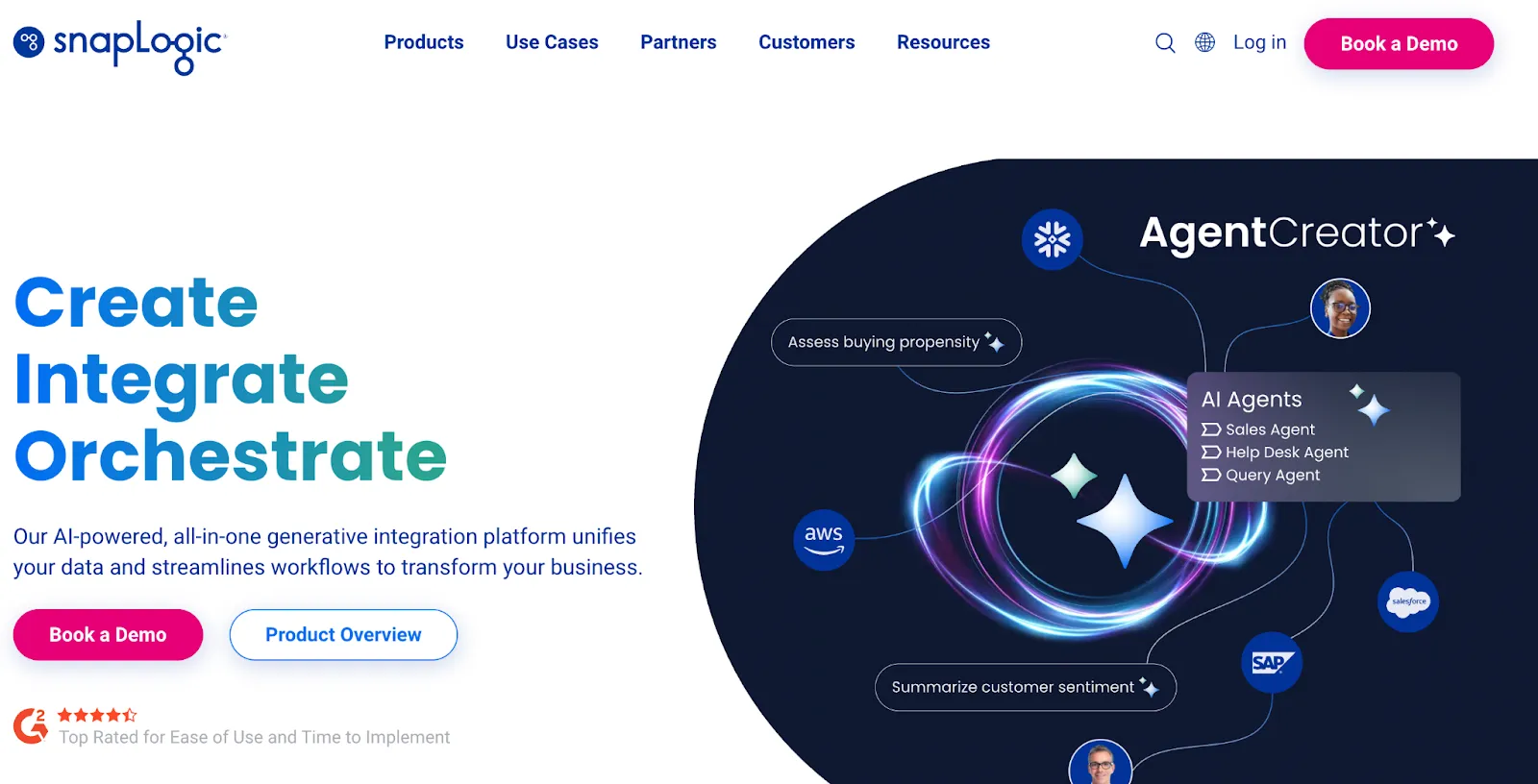
SnapLogic differentiates itself through AI-powered automation and a unique building-block approach to data integration. The platform provides over 1,000 pre-built connectors designed as modular components that enable rapid pipeline development through visual composition.
Key features
- AI-driven pipeline automation through Iris AI technology that suggests mappings and transformations
- Modular "Snap" architecture enabling building-block approach to integration development
- Large connector library with over 400 specialized integrations for enterprise and cloud systems
- Visual development environment reducing coding requirements for complex integrations
- Enterprise scalability with automatic optimization and performance tuning capabilities
6. MuleSoft
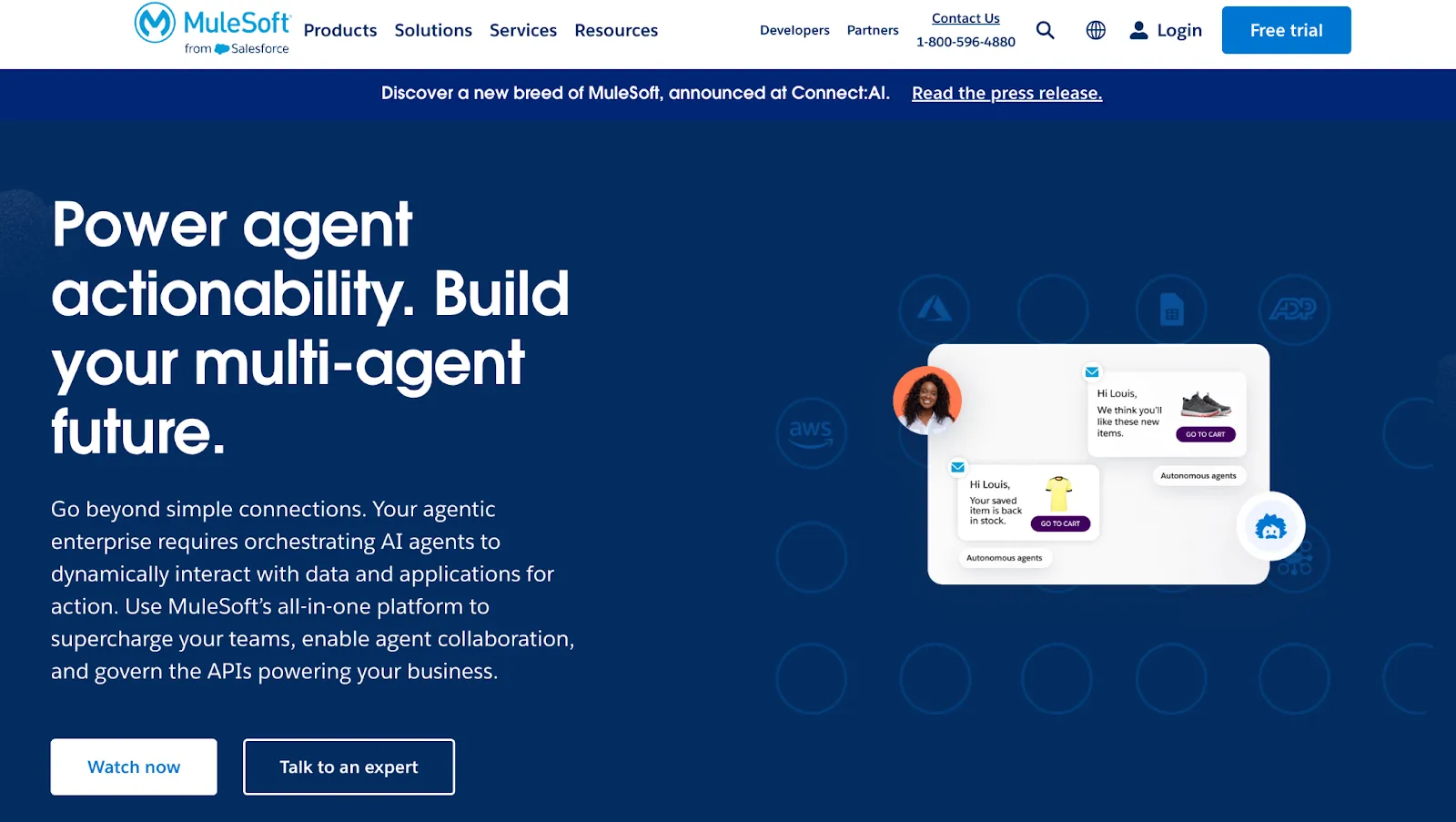
MuleSoft provides comprehensive API-led connectivity that extends beyond traditional data integration to encompass application integration and microservices architecture support. The platform emphasizes reusable integration assets and enterprise-grade security across hybrid deployment scenarios.
Key features
- API-led connectivity approach enabling reusable integration components and services
- Advanced security framework with comprehensive authentication and authorization capabilities
- Flexible architecture supporting both legacy systems and modern cloud-native applications
- Comprehensive connector library with over 1,000 integrations for enterprise and SaaS systems
- Visual development environment with code generation capabilities for complex transformations
7. IBM DataStage
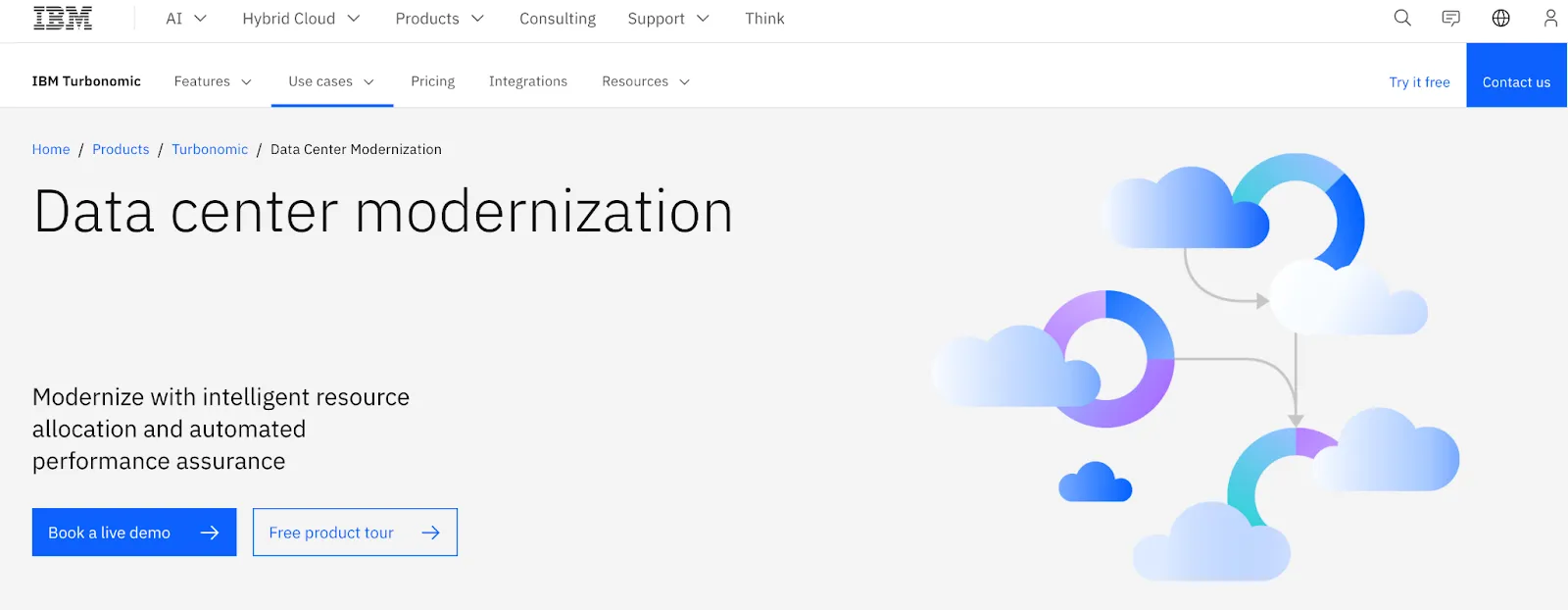
IBM DataStage represents enterprise-grade ETL capabilities with particular strength in high-performance parallel processing and comprehensive governance features. The platform integrates closely with IBM's broader cloud and analytics ecosystem while maintaining support for hybrid deployment models.
Key features
- High-performance parallel job execution optimized for large-scale data processing workloads
- Deep integration with IBM Cloud Pak for Data providing comprehensive analytics ecosystem
- Advanced lineage tracking and governance capabilities with automated compliance reporting
- Support for both batch and real-time processing across diverse data sources and formats
- Enterprise-grade security with comprehensive audit trails and access controls
8. Qlik Talend Cloud
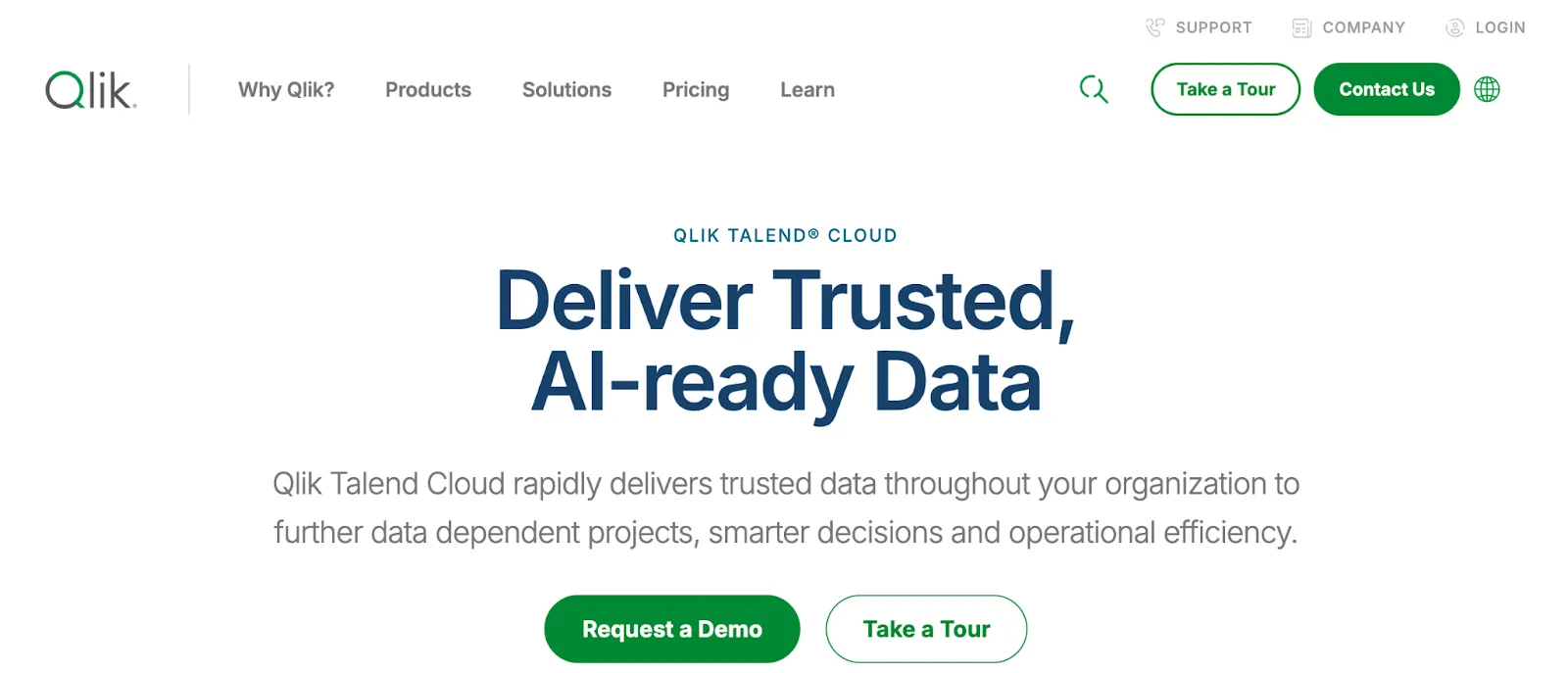
Qlik Talend Cloud combines the data integration capabilities of Talend with Qlik's analytics platform, creating a comprehensive end-to-end data management solution. The platform emphasizes cloud-native architecture while maintaining support for hybrid integration scenarios.
Key features
- Native cloud connectors optimized for modern SaaS applications and cloud data platforms
- Comprehensive transformation and data cleansing capabilities with automated quality management
- API support with CI/CD automation enabling DevOps integration and deployment workflows
- Advanced data governance with automated lineage discovery and policy enforcement
- Integration with Qlik analytics platform providing seamless transition from integration to analysis
9. Dell Boomi

Dell Boomi provides cloud-native integration platform-as-a-service with particular strength in B2B integration scenarios and low-code development capabilities. The platform emphasizes rapid deployment and ease of use while maintaining enterprise-grade performance and security.
Key features
- Low-code visual development environment accelerating integration development and deployment
- Extensive connector library with thousands of pre-built integrations covering diverse systems
- Specialized B2B and EDI capabilities supporting complex trading partner integrations
- Comprehensive API management features enabling modern application architecture patterns
- Cloud-native architecture with automatic scaling and high availability capabilities
10. Microsoft Azure Data Factory

Microsoft Azure Data Factory provides cloud-native data integration services specifically optimized for organizations already invested in the Azure ecosystem. The platform offers seamless integration with Azure analytics services while supporting hybrid connectivity to on-premises systems.
Key features
- Native integration with Azure Synapse Analytics, Databricks, and Power BI creating comprehensive analytics ecosystem
- Serverless scale-out processing capabilities handling variable workloads cost-effectively
- Comprehensive CI/CD integration with Azure DevOps enabling modern deployment practices
- Advanced monitoring and scheduling capabilities with detailed pipeline observability
- Hybrid data integration supporting connections between cloud and on-premises systems
What Key Features Should You Look For in Data Integration Solutions?
Evaluating data integration platforms requires careful consideration of specific capabilities that directly impact organizational success with large dataset management. The following features represent critical requirements that determine platform effectiveness for enterprise-scale deployments.
Scalability
Scalability capabilities must support both current data volumes and anticipated growth across multiple dimensions including data sources, processing complexity, and user populations. Platforms should demonstrate proven performance with cloud data lakes and warehouses while maintaining response times and reliability as workloads increase. Horizontal scaling capabilities enable cost-effective growth without architectural constraints.
Real-Time Integration
Real-time integration capabilities enable continuous data flows that support modern business requirements for immediate insights and rapid response to changing conditions. Platforms should support streaming data processing, Change Data Capture functionality, and event-driven architectures that minimize latency between data generation and availability for analysis.
Automation
Automation features reduce manual effort and improve reliability through intelligent pipeline management, automated error handling, and self-optimizing performance characteristics. Advanced platforms provide AI-powered capabilities that learn from usage patterns and automatically adjust processing parameters to maintain optimal performance as data characteristics evolve.
Security and Compliance
Security and compliance capabilities must address enterprise requirements for data protection, access control, and regulatory compliance across diverse deployment environments. Platforms should provide end-to-end encryption, comprehensive audit logging, and policy-based governance that automatically enforces organizational standards regardless of data source or destination characteristics.
Broad Connector Library
Broad connector library coverage ensures compatibility with existing organizational systems while supporting future technology adoption. Platforms should provide extensive pre-built connectors for popular databases, applications, and cloud services, along with capabilities for custom connector development when specialized integrations are required.
How Do You Choose the Right Data Integration Tool?
Selecting appropriate data integration platforms requires systematic evaluation of organizational requirements, technical capabilities, and strategic objectives. The decision process should balance immediate needs with long-term flexibility while considering total cost of ownership and implementation complexity.
Ease of Use
Ease of use significantly impacts adoption success and ongoing operational efficiency. Platforms with intuitive user interfaces accelerate team productivity and reduce training requirements, while visual development environments enable broader participation in integration development across technical and business teams. Consider platforms that provide both low-code capabilities for rapid development and advanced customization options for complex scenarios.
Change Data Capture (CDC)
Change Data Capture capabilities have become essential for organizations requiring real-time synchronization between operational systems and analytical platforms. Evaluate platforms based on their CDC implementation approach, supported source systems, and performance characteristics under high-volume change scenarios. Modern platforms should provide log-based CDC that minimizes source system impact while ensuring data consistency.
Data Ingestion Flexibility
Data ingestion flexibility determines platform capability to handle diverse organizational data sources and formats. Platforms should support flexible import mechanisms from APIs, databases, files, and streaming sources while maintaining performance and reliability across different data types and volumes. Consider platforms that provide both batch and real-time ingestion capabilities to address varied business requirements.
Security Implementation
Security implementation must align with organizational policies and regulatory requirements while maintaining operational efficiency. Evaluate platforms based on their encryption capabilities, access control integration, audit logging features, and compliance certifications. Consider deployment options that provide appropriate data sovereignty and security controls for sensitive information.
Silo Elimination
Silo elimination capabilities determine platform effectiveness in creating unified data access across organizational boundaries. Platforms should provide comprehensive data cataloging, lineage tracking, and governance capabilities that enable data discovery and collaboration while maintaining appropriate security and access controls.
How Do You Choose the Right Solution for Your Organization's Growth?
The right data integration platform should balance scalability, security, and ease of use while supporting both current and future business needs. For organizations seeking open-source flexibility, rapid connector development, and enterprise-grade governance, Airbyte stands out as a proven choice. Unlock the power of real-time, reliable data pipelines and transform silos into actionable insights. Start building with Airbyte today.
Frequently Asked Questions
What is the difference between ETL and ELT?
ETL transforms data before loading into the target system, suited for structured data and traditional warehouses. ELT loads raw data first and transforms it in the destination, leveraging cloud processing power for large datasets and offering more flexibility and efficiency.
How can data integration improve business intelligence?
Data integration provides a unified, reliable data foundation by consolidating multiple sources. It eliminates silos, reduces inconsistencies, and enables comprehensive analysis, allowing organizations to generate accurate insights, make informed decisions, and drive operational efficiency and growth.
What is the role of data connectors?
Data connectors enable integration platforms to access and move data from diverse sources like databases, APIs, and SaaS systems. They handle authentication, extraction, and format conversion, forming the essential infrastructure for automated, reliable data flow across enterprise environments.

.webp)
.webp)